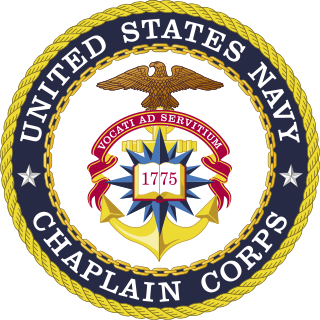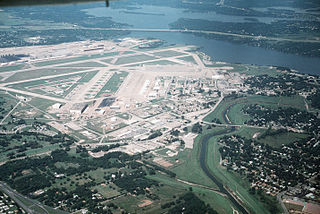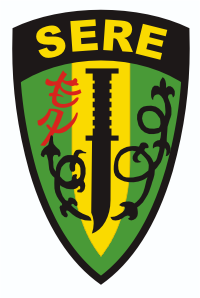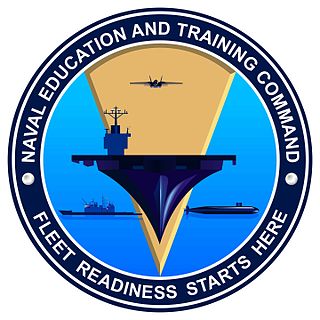An officer candidate school (OCS) is a military school which trains civilians and enlisted personnel in order for them to gain a commission as officers in the armed forces of a country. How OCS is run differs between countries and services. Typically, officer candidates have already attained post-secondary education, and sometimes a bachelor's degree, and undergo a short duration of training which focuses primarily on military skills and leadership. This is in contrast with a military academy which includes academic instruction leading to a bachelor's degree.
United States special operations forces (SOF) are the active and reserve component forces of the United States Army, Marine Corps, Navy and Air Force within the US military, as designated by the Secretary of Defense and specifically organized, trained, and equipped to conduct and support special operations. All active and reserve special operations forces are assigned to the United States Special Operations Command (USSOCOM).

The Air Education and Training Command (AETC) is one of the nine Major Commands (MAJCOM) of the United States Air Force (USAF), reporting to Headquarters, United States Air Force. It was established 1 July 1993, with the realignment of Air Training Command and Air University.

Uniformed Services University of the Health Sciences (USU) is a health science university and professional school of the U.S. federal government. The primary mission of the school is to prepare graduates for service to the U.S. at home and abroad as uniformed health professionals, scientists and leaders; by conducting cutting-edge, military-relevant research; by leading the Military Health System in key functional and intellectual areas; and by providing operational support to units around the world.

The United States Navy Chaplain Corps is the body of military chaplains of the United States Navy who are commissioned naval officers. Their principal purpose is "to promote the spiritual, religious, moral, and personal well-being of the members of the Department of the Navy," which includes the Navy and the United States Marine Corps. Additionally, the Chaplain Corps provides chaplains to the United States Coast Guard.

Naval Air Station Joint Reserve Base Fort Worth includes Carswell Field, a military airbase located 5 nautical miles west of the central business district of Fort Worth, in Tarrant County, Texas, United States. This military airfield is operated by the United States Navy Reserve. It is located in the cities of Fort Worth, Westworth Village, and White Settlement in the western part of the Fort Worth urban area.

A military chaplain ministers to military personnel and, in most cases, their families and civilians working for the military. In some cases, they will also work with local civilians within a military area of operations.

Survival, Evasion, Resistance, and Escape (SERE) is a training program, best known by its military acronym, that prepares U.S. military personnel, U.S. Department of Defense civilians, and private military contractors to survive and "return with honor" in survival scenarios. The curriculum includes survival skills, evading capture, application of the military code of conduct, and techniques for escape from captivity. Formally established by the U.S. Air Force at the end of World War II and the start of the Cold War, it was extended to the Navy and United States Marine Corps and consolidated within the Air Force during the Korean War (1950–1953) with greater focus on "resistance training".

Joint Base McGuire–Dix–Lakehurst is a United States military facility located 18 miles (29 km) southeast of Trenton, New Jersey. The base is the only tri-service base in the United States Department of Defense and includes units from all six armed forces branches.

The Naval Education and Training Command (NETC) is an enterprise-level shore command of the United States Navy with more than 19,000 military and staff personnel at more than 1,640 subordinate activities, sites, districts, stations, and detachments throughout the world, and was established in 1971. NETC recruits, trains and delivers those who serve the nation, taking them from "street to fleet" by transforming civilians into highly skilled, operational, and combat ready warfighters.

The Air War College (AWC) is the senior Professional Military Education (PME) school of the U.S. Air Force. A part of the United States Air Force's Air University, AWC emphasizes the employment of air, space, and cyberspace in joint operations. Headquartered at Maxwell Air Force Base in Montgomery, Alabama, its higher headquarters is the Air Education and Training Command (AETC) at Randolph Air Force Base in San Antonio, Texas. It is one of six war colleges within the U.S. Department of Defense's Joint Professional Military Education (JPME) Phase II Education Program for commissioned officers.

The United States Army Chaplain Corps (USACC) consists of ordained clergy of multiple faiths who are commissioned Army officers serving as military chaplains as well as enlisted soldiers who serve as assistants. Their purpose is to offer religious church services, counseling, and moral support to the armed forces, whether in peacetime or at war.

John L. "Jack" Hudson is a retired lieutenant general in the U.S. Air Force. He was Commander, Aeronautical Systems Center, Wright-Patterson Air Force Base, Ohio (WPAFB). Hudson also served as a member of the Senior Executive Service as the Director of the National Museum of the United States Air Force at WPAFB from 2009 to 2018.

The Chaplain Corps of the United States Air Force (USAF) is composed of both clergy—commissioned officers who have been endorsed and ordained by a religious organization—and enlisted Religious Affairs. As military chaplains, their main purpose is to support the free exercise of religion by members of the military service, their dependents, and other authorized personnel. They also provide advice on spiritual, ethical, moral, and religious-accommodation issues to the leadership of the United States Department of Defense.

Chaplain Cecil Roland Richardson, USAF, retired as the 16th Chief of Chaplains of the United States Air Force, effective June 1, 2012, with an official retirement ceremony on May 30, 2012. He was appointed to that assignment on May 28, 2008.

The Armed Forces Chaplains Board (AFCB) is an organizational entity within the United States Department of Defense established to provide advice and recommendations to OSD officials on policies and issues related to the free exercise of religion and on all matters concerning religion, spiritual readiness, morality, ethics, morale, and military chaplains. It is made up of the three Chiefs of Chaplains and three active-duty Deputy Chiefs of Chaplains of the Army, Navy, and Air Force.

Religious symbolism in the United States military includes the use of religious symbols for military chaplain insignia, uniforms, emblems, flags, and chapels; symbolic gestures, actions, and words used in military rituals and ceremonies; and religious symbols or designations used in areas such as headstones and markers in national cemeteries, and military ID tags.

In addition to the three official Chaplain Corps seals for the army, navy, and air force, chaplaincies also have special seals and emblems for special schools and organizations for their chaplains, as well as a shared emblem for the "Armed Forces Chaplaincy Center" (AFCC), Fort Jackson, Columbia, South Carolina, where chaplains from all branches of the military receive their training. The original AFCC emblem had three symbols traditionally associated with learning and wisdom—a lamp, a torch and a book. A second emblem was developed by the Commandants and Commanding Officer of the three schools, in part so that it could be used on the reverse side of a two-sided AFCC challenge coin, with one symbol drawn from each of the army, navy, and Chaplain Corps emblems: a dove from the army emblem, cupped hands from the air force emblem, and an anchor from the navy emblem. In addition to using both emblems on the two sides of the AFCC coin, both designs were displayed in the AFCC lobby.



























